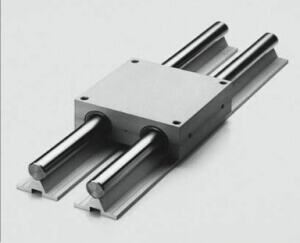In manufacturing automation, linear guides and sliding guides are the core of precise linear motion—choosing the right one directly impacts your equipment’s accuracy, stability, and lifespan. Countless engineers mix up linear guides and sliding guides, thinking they’re interchangeable. But linear guides and sliding guides differ drastically in structure, performance, and use cases. This article breaks down the key differences between linear guides and sliding guides to simplify your selection.
I. Essential Definition: Motion Principle Determines Core Differences
Linear guides, by contrast, are "rolling friction" kinematic pairs, consisting of core components such as guide rails, sliders, steel balls, and reversers. During operation, the steel balls inside the slider roll between the raceways of the guide rail and the slider, achieving circular motion through the reverser. This "replacing sliding with rolling" design fundamentally changes the friction mechanism and brings a qualitative leap in performance. Well-known best-selling products of YOSO MOTION, such as the SBR12 circular linear guide and MGN micro linear guide, all fall into the category of linear guides.
Sliding guides belong to "surface contact" kinematic pairs. Their structure usually consists of a fixed guide (slide rail) and a moving guide (slide block), and linear motion is achieved through direct sliding between the contact surfaces of the two. To reduce friction, lubricating oil is applied to the contact surfaces, and some high-end models are equipped with oil grooves for oil storage. This structure is the most traditional type of guide and has been widely used since the early days of the machinery industry.


This rolling friction design cuts energy waste and maintains consistent motion accuracy—why linear guides are critical for high-precision automation. YOSO MOTION’s SBR and YGH series have gained global recognition for leveraging this tech, with proven performance in electronics and automotive facilities.
2. Load-Bearing Capacity: Each Has Its Advantages, Adapting to Different Scenarios
Each guide excels in specific load scenarios. Sliding guides’ surface contact handles large static loads/impacts (e.g., heavy machine tool beds) by distributing stress evenly—linear guides risk steel ball cracking here.
YOSO SBR Sliding Guides

This load split ensures reliability. A mining client used sliding guides for 10-ton static conveyor loads; automated logistics clients prefer linear guides for smooth dynamic load handling (pallets, robotic arms).
Linear guides excel at dynamic/radial loads, with steel balls spreading weight across raceways. Avoid heavy impacts (risk of cracked balls). Use linear guides for medium-light, high-frequency applications; sliding guides for heavy-duty, low-speed work.
3. Maintenance Cost: Linear Guides Are More Worry-Free
Sliding guides have high wear, requiring monthly lubrication and cleaning (critical in swarf-prone shops). Skipping maintenance causes seizing, costing full shifts of downtime.
Linear guides’ rolling friction minimizes wear. YOSO MOTION’s sealed, self-lubricating designs resist dust (proven in PCB shops) with 6-12 month maintenance cycles—downtime savings justify use in 24/7 lines.
4. Installation Difficulty: Linear Guides Are Easier for Standardized Installation
Sliding guides need precision on-site scraping for flat contact surfaces—days of specialist work. Poor fit causes rapid wear and accuracy loss; not for new hires.
Linear guides’ modular design simplifies installation: align rails, bolt down—no on-site precision work. Interns master it in an hour. This ease drives YOSO MOTION’s popularity.
Selection Guide: 3 Steps to Lock in the Right Guide for You
Picking the right guide follows three practical steps:
YOSO MOTION: Guide Selection Is a Microcosm of Industrial Upgrading
Guide selection reflects manufacturing’s shift to precision automation. Linear guides dominate this trend—YOSO MOTION holds nearly 70% of Alibaba’s bestseller list by delivering shop-ready performance.
There’s no "better" guide—only the right fit. This breakdown simplifies selection. Comment with specific models or applications for personalized advice.
B{Clarify Core Requirements}\n B -->|High Precision/High-Frequency Motion/Low Maintenance| C[Prioritize Linear Guides]\n B -->|Simple Equipment/Heavy Load/Low Speed/Limited Budget| D[Prioritize Sliding Guides]\n C --> E{Match Application Scenarios}\n D --> E\n E -->|Precision Machining/Electronics/Robotics| F[Confirm Linear Guides]\n E -->|Heavy Machine Tools/Manual Equipment| G[Confirm Sliding Guides]\n F --> H{Calculate Total Cost of Ownership}\n G --> H\n H -->|Long-Term Operation/High Automation| I[Final Choice: Linear Guides]\n H -->|Short-Term Use/One-Time Project| J[Final Choice: Sliding Guides]\n I --> K[Selection Completed]\n J --> K","theme":"default","view":"chart"}},"DC2vfHL4KdRHOlcvrtocuDFVnrf":{"id":"DC2vfHL4KdRHOlcvrtocuDFVnrf","snapshot":{"align":"","author":"3710198389154762","children":["MacbfaYs9dkhp0cqKOGcwY1qnSh","WKnYfULajduRJHcUoHtc1ormnBh","NZYHf3BAcdoXonctaBIcHkIanoy","OMSZfXeHhd15JLcIzT4cgQElnkf","FE5sf7a9ydJOmjcEkvtcIZvMn2H","JJe0fDKBXdLBWpclH0ecNwNDnLb","KLf0flTwidAzMucJfpUcqTEFnmc","WIVKfjuLudyYIVcKv9YcNnZKnKb","SR9ffi9yxdrve2cupgXcxf7pnzh","EHkTfSVWmdjZeycvY4rc6odNnpf","SFuFf1ro8dZbktclz7pcfK5Znsf","OfHqfd5U4dgqJYcDOvLccnffnSg","FZljfZCxUdRQP7ctLgUcJuf1nNS","OWR7f0zTDdEkUocXGOIcw7cWnZe","VkAmfqr95d55chcuvebc97onnUd","EmlqfrYWQdCHqBcpnYucQyAFntd","Uip9fYJ2od4qtpcLSzJc0O9ynxc","CRWEfwc4LdPC9HcGcMic4b80nse","Q7zOfzHrGdp2Rjc5Ia5cY5lhnMf","Xmv0f7Setdwruhcl2yncq09VnMe","ZA5KfeyeBdo7QUcGQCtcax2bnwf","Q25vf1gaGdD79CcKKUAcojwYnxg","VGtRfDISWdSqCqcN9I3cySZknqf","Bw4SfdZbHdRZbOcjLUIcSzKUn9b","XIrMfZuIddMbrTcvu83c9uNYn7b","SIuKfN0c4dfHSycRCqscl3wZnrc","IGmOfuCT3dvDyLc9gYwcJ8O4n1g","LwuBfMnDkdq7xdcXqbQcJqh5nAb","M9dZfFFThdZwjwcGO4ScfVX8nac","UQ33f4mRfdJisScC8frcDLMknYe","S3i4fcQ8md0KCyc2KZ7c0twzn3f","EVeofzMrZdeXd1cmamic1VVOnle","Bb20fQx2Xd7h5IcF30ucXdLJnFo","ICkYfdKTWdnsKicEOlvcGKTlnWu","YPvCf30DTdbBDBctd2cclUcXnQb","KDMkf7pWzdWaPycBEYfcuYNhnud","NuaJf44lldo7HpcUxEfcwVFCn9f","MNMFfeCvLdUdkHcl5lJcW9FFnue","TTxrf9cqtdFZQ7cmueNcYCkWnHg","NynDfTYtPdSMP9cgMOkc9qLPnSe","GOWEfdzS2d5GTucHwrzcPEiBnFh","Ycdufx6H5dNlKgcWboacRdDjnPb","IHZUf4x3GdLTsJc2cZXcH5JxnEc"],"comment_container_id":"JgBXfu3R4dyGZAcjDnlcgotTnId","comments":[],"doc_info":{"deleted_editors":null,"editors":["3710198389154762"],"option_modified":null,"options":["editors","create_time","edit_time"]},"hidden":false,"locked":false,"parent_id":"","revision_container_id":"ReS9fMTOEd7tMwcwJ2NcJRRwnRb","revisions":[],"status":{"streaming":{"enabled":false,"expired_at":"1763367228","source":1,"operator_id":"3710198389154762"}},"text":{"apool":{"numToAttrib":{"0":["author","3710198389154762"]},"nextNum":1,"attribToNum":{"author,3710198389154762":0}},"initialAttributedTexts":{"text":{"0":"Linear Guides vs Sliding Guides: Core Differences & Selection Guide"},"attribs":{"0":"*0+1v"},"rows":{},"cols":{}}},"type":"page"}}},"payloadMap":{},"extra":{"channel":"saas","pasteRandomId":"32903089-f853-4d31-9a39-0d49e0fc81d5","mention_page_title":{},"external_mention_url":{}},"isKeepQuoteContainer":false,"selection":[{"id":54,"type":"block","recordId":"NuaJf44lldo7HpcUxEfcwVFCn9f"}],"pasteFlag":"aa98c37a-1174-4728-be27-dd0ce9c5087d"}">
B{Clarify Core Requirements}\n B -->|High Precision/High-Frequency Motion/Low Maintenance| C[Prioritize Linear Guides]\n B -->|Simple Equipment/Heavy Load/Low Speed/Limited Budget| D[Prioritize Sliding Guides]\n C --> E{Match Application Scenarios}\n D --> E\n E -->|Precision Machining/Electronics/Robotics| F[Confirm Linear Guides]\n E -->|Heavy Machine Tools/Manual Equipment| G[Confirm Sliding Guides]\n F --> H{Calculate Total Cost of Ownership}\n G --> H\n H -->|Long-Term Operation/High Automation| I[Final Choice: Linear Guides]\n H -->|Short-Term Use/One-Time Project| J[Final Choice: Sliding Guides]\n I --> K[Selection Completed]\n J --> K","theme":"default","view":"chart"}},"DC2vfHL4KdRHOlcvrtocuDFVnrf":{"id":"DC2vfHL4KdRHOlcvrtocuDFVnrf","snapshot":{"align":"","author":"3710198389154762","children":["MacbfaYs9dkhp0cqKOGcwY1qnSh","WKnYfULajduRJHcUoHtc1ormnBh","NZYHf3BAcdoXonctaBIcHkIanoy","OMSZfXeHhd15JLcIzT4cgQElnkf","FE5sf7a9ydJOmjcEkvtcIZvMn2H","JJe0fDKBXdLBWpclH0ecNwNDnLb","KLf0flTwidAzMucJfpUcqTEFnmc","WIVKfjuLudyYIVcKv9YcNnZKnKb","SR9ffi9yxdrve2cupgXcxf7pnzh","EHkTfSVWmdjZeycvY4rc6odNnpf","SFuFf1ro8dZbktclz7pcfK5Znsf","OfHqfd5U4dgqJYcDOvLccnffnSg","FZljfZCxUdRQP7ctLgUcJuf1nNS","OWR7f0zTDdEkUocXGOIcw7cWnZe","VkAmfqr95d55chcuvebc97onnUd","EmlqfrYWQdCHqBcpnYucQyAFntd","Uip9fYJ2od4qtpcLSzJc0O9ynxc","CRWEfwc4LdPC9HcGcMic4b80nse","Q7zOfzHrGdp2Rjc5Ia5cY5lhnMf","Xmv0f7Setdwruhcl2yncq09VnMe","ZA5KfeyeBdo7QUcGQCtcax2bnwf","Q25vf1gaGdD79CcKKUAcojwYnxg","VGtRfDISWdSqCqcN9I3cySZknqf","Bw4SfdZbHdRZbOcjLUIcSzKUn9b","XIrMfZuIddMbrTcvu83c9uNYn7b","SIuKfN0c4dfHSycRCqscl3wZnrc","IGmOfuCT3dvDyLc9gYwcJ8O4n1g","LwuBfMnDkdq7xdcXqbQcJqh5nAb","M9dZfFFThdZwjwcGO4ScfVX8nac","UQ33f4mRfdJisScC8frcDLMknYe","S3i4fcQ8md0KCyc2KZ7c0twzn3f","EVeofzMrZdeXd1cmamic1VVOnle","Bb20fQx2Xd7h5IcF30ucXdLJnFo","ICkYfdKTWdnsKicEOlvcGKTlnWu","YPvCf30DTdbBDBctd2cclUcXnQb","KDMkf7pWzdWaPycBEYfcuYNhnud","NuaJf44lldo7HpcUxEfcwVFCn9f","MNMFfeCvLdUdkHcl5lJcW9FFnue","TTxrf9cqtdFZQ7cmueNcYCkWnHg","NynDfTYtPdSMP9cgMOkc9qLPnSe","GOWEfdzS2d5GTucHwrzcPEiBnFh","Ycdufx6H5dNlKgcWboacRdDjnPb","IHZUf4x3GdLTsJc2cZXcH5JxnEc"],"comment_container_id":"JgBXfu3R4dyGZAcjDnlcgotTnId","comments":[],"doc_info":{"deleted_editors":null,"editors":["3710198389154762"],"option_modified":null,"options":["editors","create_time","edit_time"]},"hidden":false,"locked":false,"parent_id":"","revision_container_id":"ReS9fMTOEd7tMwcwJ2NcJRRwnRb","revisions":[],"status":{"streaming":{"enabled":false,"expired_at":"1763367228","source":1,"operator_id":"3710198389154762"}},"text":{"apool":{"numToAttrib":{"0":["author","3710198389154762"]},"nextNum":1,"attribToNum":{"author,3710198389154762":0}},"initialAttributedTexts":{"text":{"0":"Linear Guides vs Sliding Guides: Core Differences & Selection Guide"},"attribs":{"0":"*0+1v"},"rows":{},"cols":{}}},"type":"page"}}},"payloadMap":{},"extra":{"channel":"saas","pasteRandomId":"8134ad9d-2d0a-4c6a-bfdf-76f4fb4939ee","mention_page_title":{},"external_mention_url":{}},"isKeepQuoteContainer":false,"selection":[{"id":54,"type":"block","recordId":"NuaJf44lldo7HpcUxEfcwVFCn9f"}],"pasteFlag":"aa98c37a-1174-4728-be27-dd0ce9c5087d"}">



 EN
EN
 AR
AR
 BG
BG
 CS
CS
 DA
DA
 NL
NL
 FI
FI
 FR
FR
 DE
DE
 EL
EL
 HI
HI
 IT
IT
 JA
JA
 KO
KO
 NO
NO
 PL
PL
 PT
PT
 RU
RU
 ES
ES
 SV
SV
 TL
TL
 ID
ID
 UK
UK
 VI
VI
 HU
HU
 TH
TH
 TR
TR
 FA
FA
 AF
AF
 MS
MS
 SW
SW
 GA
GA
 CY
CY
 BE
BE
 KA
KA
 LA
LA
 MY
MY
 TG
TG
 UZ
UZ


